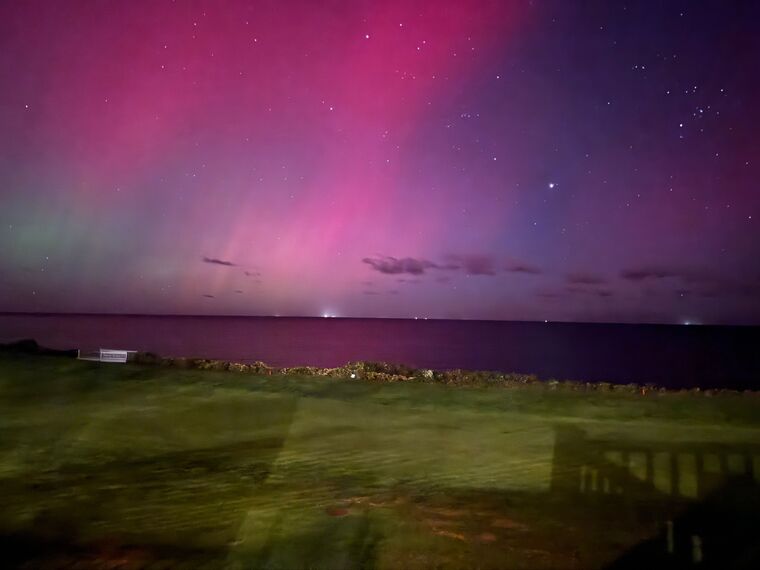Best posts made by SSmith1226
-
RE: A little humourposted in Lounge
@administrator said in A little humour:
You gotta eat whatever the local environment produces, I guess. I keep hearing something about cats and dogs...
Reykjavik, Iceland:



-
Swiss Set World Record For Largest Alphorn Ensembleposted in Lounge
“Over a thousand (1,006) alphorn players gathered on Klewenalp in Canton Nidwalden. At the gathering, they played choral melodies and broke the world record for the largest alphorn ensemble.”
-
RE: How about a "Random Meaningless Image...let's see them string"?posted in Lounge
1 hr and 45 minutes later in the same spot, overlooking Cape Cod Bay, The Northern Lights!



Three hrs after the above photos





-
RE: Zoom and Trumpet Boardsposted in Music Discussion
Wayne,
It is good to see that great minds think alike. I proposed this 17 days ago and thus far no brave souls other than me, and now you, have volunteered.
Here is the link to that discussion:https://trumpetboards.com/topic/711/trumpet-board-performance/7
If there are enough volunteers, I will send you some music to look at.
-
RE: Progress in my comebackposted in Comeback Players
@j-jericho said in Progress in my comeback:
Nice story. I think we'll hear more from her in the future.
Entering the time machine, here is another child prodigy through the years who is now age 22, Lucienne Renaudin Vary.
“French trumpeter Lucienne Renaudin Vary can be called a prodigy, making major concert appearances in French venues throughout her teenage years and releasing her first major-label album at 18. Her training and her debut album on Warner Classics have been notable for their mixture of classical, jazz, and pop repertory.
Vary was born in Saint-Sébastien-sur-Loire, France, on January 28, 1999. Showing talent early on the trumpet, she enrolled at the Conservatory of Le Mans in 2007, taking classical trumpet lessons from Philippe Lafitte and jazz instruction from Santiago Quintans. At the Conservatoire National Supérieur de Musique et de Danse in Paris, she matriculated at first as a classical trumpet student, under Clément Garrec, but in 2017 she added jazz and improvisation to her course of study. Vary's record of strong competition showings began in 2010 with a win at the Selmer Le Parnasse contest, and in November of that year she finished third in the European Competition for Young Trumpet Players, even though the contest was for players 14 through 17, and she was only 11.
Vary made her first festival appearances in 2012 at the Eurochestrie and Annecy festivals. In 2013 she appeared on French television in a tribute to trumpeter Maurice André, and by 2014 she had a busy festival schedule that included appearances in Colmar, Antibes, and Royan, performing at the last-named in a duet with star English trumpeter Alison Balsom. She also gave her first major jazz concert that year, in Le Mans at the city's Nuit de chimères event. Since then, she has divided her time roughly equally between classical and jazz appearances. Vary won a Victoire de la musique classique award in 2016 in the category of Instrumental Soloist Revelation. She made a guest soloist appearance at the Cartagena Music Festival in Colombia in 2017, becoming the festival's youngest-ever soloist and making her debut in the Americas.
The Voice of the Trumpet
In 2013
Vary made her recording debut on an album by French trumpeter Guy Touvron, playing a work by Benedetto Marcello and joining Touvron on two-trumpet concertos by Saverio Mercadanteand G.F. Handel. In 2016 she was signed to the Warner Classics label and issued her solo debut, The Voice of the Trumpet, the following year. The program combined classical works, few of them standards, with jazz treatments of Broadway hits.”At age 16:
At age 19:
At age 21:
-
RE: Odd Mouthpiceposted in Flugelhorns & Cornets
The following site addresses the differences in the various Flugelhorn Shank sizes and gives a list of the various brands of Flugelhorns that use each shank size. You have a Small Morse, or Bach Shank, which would explain your ill fitting mouthpiece.
https://bobreeves.com/blog/the-ultimate-flugelhorn-mouthpiece-shank-guide/
-
RE: Looking for F trumpetposted in Historical & Collector's Items
@barliman2001 said in Looking for F trumpet:
To make quite clear why I am looking for an F Alto trumpet: Together with a few other people, I've founded an amateur original sound orchestra here in Vienna. We don't go for Baroque original sound - too expensive for amateurs - but rather for Classical and Romantic era music. Lots of the trumpet parts at this time were written for trumpet in F... so any hybrids or weirdos like Frumpets are out of the question.
Here is another “out of the question” “hybrid and Weirdo”, the Berkeley Double Bell Bb/F Trumpet. The F side plays through a single bell configuration. The video starts with Bb version and at 1:12 switches configuration and plays on the F Trumpet. Later, it switches bells, I believe back to Bb configuration using a piccolo trumpet bell, playing on a standard Bb length trumpet.
Never the less, since the F Trumpets are quirky at best, generally with intonation and accuracy problems, this should fit right in!
-
RE: A little humourposted in Lounge
Figured it out!!! On the iPhone the screen did not display the entire tool bar (photo 3). The tool bar slides to the left and displays the arrow pointing up (photo 2). This button ( photo 1) allows linking of the photo in the photo app to the post. I didn’t realize this until seeing the entire tool bar on the wider iPad screen.
Steve Smith -
RE: Longest Layoffposted in Music Discussion
My layoff was 44 years. Life, including school, work, and eventually family got in the way. I started playing again in 2016, when I started slowing down at work. For the first six months I played by ear only. My regular progressive lenses were locked in to about 14-16 inches to focus for work and would not allow me to read music at trumpet length and beyond. After six months I had “music glasses” made and I could once again see the music. The comeback was slow but has been steady.
-
RE: >OLDS Recording...posted in Bb & C Trumpets
@barliman2001 said in >OLDS Recording...:
and I cut short a holiday in Italy to be in their shop on Saturday morning... happy!
Congratulations on your new horn! However, what is much more important to many of us is, how did you convince your wife to end your Italian vacation early, in order for you to purchase an old trumpet. How ever you did it must have been brilliant, especially since you lived to write about it!!! Or, did you have to dictate this post?
-
RE: Tutankhamen's Trumpetsposted in Historical & Collector's Items
@J-Jericho
All I have to say to that is tekiah, shevarim, t'ruah, tekiah gedolah and the walls came tumbling down. -
RE: A little humourposted in Lounge
@tjcombo
Tjcombo,
I did figure it out. Check out my post on page one of this thread just below the photo that talks about thanking your father for bringing you into this world.
The tool bar is longer than the screen is wide. It will slide to the left and expose an upward pointing arrow as illustrated in my post. That arrow will give you access to your photos on your iPhone.
At least that is what worked for me. Good luck.
Steve Smith -
RE: Trumpet solo in ice castlesposted in Historical Database
If this topic is about the Trumpet Solo on the Ice Castles Theme instrumental, as recorded by Marvin Hamlisch, it appears that the most likely artist was John Harner. I base this on the old thread from TH, “The Great Unknown trumpet player on old 1979 Ice Castles recording”. There were several possibilities suggested, but the last post in this thread gives second hand confirmation that John Harner played and recorded this. Below is the link to the TH discussion, a link to a short biography of John Harner, and a YouTube video of the instrumental recording. The Trumpet Solo begins around 2:35.
https://www.trumpetherald.com/forum/viewtopic.php?t=768
-
Franz Streitwieser and the “plus one” phenomenonposted in Bb & C Trumpets
The following is an article from yesterday’s New york Times:

Franz Streitwieser, a German-born trumpeter who amassed a collection of brass instruments that encompassed centuries of music history and drew musicians from around the world to its home in a converted barn in Pennsylvania, died on Nov. 8 in a hospice in Sebring, Fla. He was 82.
The cause was Alzheimer’s disease, his son Bernhard said.
While a performer by profession — on one of the most extroverted of orchestral instruments, no less — Mr. Streitwieser had the soul of an archivist.
He took a 19th-century yellow-and-white barn in bucolic Pennsylvania and converted it into a museum to house one of the world’s largest collections of brass instruments and to serve as well as a concert space. The Streitwieser Foundation Trumpet Museum, in Pottstown, opened in 1980 and was home to approximately 1,000 items until 1995, when it found a new home in Europe.
Mr. Streitwieser (pronounced STRITE-vee-zer) sought to elevate the trumpet’s status.
“When somebody finds an old violin in the attic, they think it’s a Stradivarius and it’s valuable,” he told The Philadelphia Inquirer in 1983. “But when somebody finds an old brass instrument in the attic, they just throw it out. We want to change that.”
ADVERTISEMENT
Continue reading the main story
In addition to its standard brass fare, including valved trumpets, French horns and trombones, the museum showcased a variety of curiosities: over-the-shoulder trumpets used in the Civil War, replicas of Bronze Age Viking trumpets, horns carved from elephant tusks. Visitors would have encountered a life-size cardboard cutout of the composer John Philip Sousa and a 12-foot-long horn carved from pine wood, made for Swiss shepherds.
Mr. Streitwieser situated the museum in Pottstown because he and his wife, Katherine, had moved there to be closer to her relatives. She was a descendant of the DuPont family, of chemical company renown, which helped support the museum.
The museum stood on a 17-acre plot called Fairway Farm (it also had a bed-and-breakfast), and it drew brass devotees from far and wide. The music historian Herbert Heyde, who later curated the Metropolitan Museum of Art’s instrument collection, spent six months cataloging the Pottstown museum’s contents in the 1990s.
But Pottstown, which is about 40 miles from Philadelphia and closer in culture to the state’s rural center, lacked strong funding for arts programs, and attendance at the museum lagged. After Ms. Streitwieser’s death in 1993, Mr. Streitwieser could not afford to keep the museum going and was forced to find a new home for his trove. Local universities expressed interest, but none had the space.
ADVERTISEMENTIt was Austria to the rescue. Kremsegg Castle, near Linz, was establishing a government-funded musical instrument museum, and officials there knew of Mr. Streitwieser as a prominent collector. They offered to take in his holdings — and him as well, as a consultant. The collection was packed up and sent off in 1995.
Franz Xaver Streitwieser was born on Sept. 16, 1939, in Laufen, Germany, a Bavarian town just across the border from Austria. He was one of five children of Simon and Cecilia (Auer) Streitwieser, who were farmers.
As a boy, Franz visited a music store with his mother one day and felt drawn to a gleaming brass trumpet. But it was prohibitively expensive, so the shopkeeper pointed him to a tarnished, less costly trumpet toward the back of the store. He bought it, and after a teacher of his gave him a can of polish, it gleamed. It was the first of many instruments in his life.
Franz soon joined the town band and went on to Mozarteum University Salzburg in Austria, graduating in 1961 with a degree in trumpet performance.
ADVERTISEMENT
Continue reading the main storyWhile at the university he met Katherine Schutt, an oboe and piano student from Wilmington, Del. Their courtship played out during the filming of “The Sound of Music” in and around Salzburg, and the couple became extras in several scenes.
Mr. Streitwieser and Ms. Schutt married in 1963. They lived mainly in Freiburg, Germany, where Mr. Streitwieser was principal trumpet of the Freiburg Philharmonic from 1965 to 1972. Traveling to the United States regularly, he spent a year in New York City studying at Juilliard. The couple had five children, one of whom, Heinrich, died in infancy.
Mr. Streitwieser began collecting brass instruments early on in Freiburg — his son Bernhard said the family home sometimes resembled a trumpet repair shop.In 1977, Mr. Streitwieser worked with the German instrument maker Hans Gillhaus in designing a modern version of the corno da caccia, a circular horn popular in the 18th century; they called it a clarinhorn.
ADVERTISEMENTThe family moved to Pottstown in 1978. Mr. Streitwieser played in local orchestras and in 1980 received a master’s degree in music from the University of South Dakota. With Ralph T. Dudgeon, he wrote “The Flügelhorn” (2004), a history of that member of the trumpet family.
After the death of his first wife, Mr. Streitwieser married Katharine Bright in 1994 and soon moved with her to Austria in the company of his brass collection. The couple spent half the year in an apartment in the 13th-century Kremsegg Castle, at home among their horns. The rest of the time they lived in Florida, moving for good to Lake Wales, in the central part of the state, in 2004. Mr. Streitwieser founded a brass quintet and continued to perform in local festivals.The Streitwieser collection remained at Kremsegg until the musical instrument museum closed in 2018. Much of its contents were moved to Linz Castle and Museum or other museums in Upper Austria.
In addition to his son Bernhard, Mr. Streitwieser is survived by his wife; his sons Erik and Charles; his daughter, Christiane Bunn; his stepdaughter, Henrietta Trachsel; a sister, Anna Breitkreutz Neumann; and 13 grandchildren.
ADVERTISEMENTDr. Dudgeon, who also played music with Mr. Streitwieser and help catalog the brass collection, said he first heard of him in the 1970s. He had come to pick up a purchase from a Massachusetts music store and found that the shop had very few brass instruments left.
-
RE: Community Bandposted in Classical / Orchestral
I had an interesting experience this week. Several months ago I got accepted to the Florida “All Star Community Band”. It is made up of around 110 musicians from around fifty or more community bands from all over the state who are recommended by their local band directors. Every few years this band forms and performs at the State of Florida Band Directors Conference. In general, each player in the band comes from the first or second seat in their home band’s section. Through attrition, not talent, I as a three and a half year comeback player, sit in the second seat of the first trumpet section of my home band. Most of the participsnts have extended experience and are great musicians. Each piece played is chosen and conducted by different “all star” conductors from around the state.
We all got together for the first time Monday afternoon and evening. Our rehearsal lasted over 5 hours.
At 8:15 am Tuesday we met again and rehearsed until 5:00 pm with a 1 hr lunch break.
Wednesday we met at 8:15 am again and rehearsed until 12 noon including a dress rehearsal from 11:00 to 12:00. At 3:30 we started our 1 hr concert. By the start of the concert, my lip was like a piece of wood. Fortunately I was one of four people assigned second cornet / trumpet, but never the less the pieces were quite challenging.
Out of curiosity, have any of you experienced such intense sessions culminating in a high profile, high level performance without major rest? If so, was this at an amateur level, or professional level. Is this what a professional band or orchestra goes through routinely, or is this an exception. I felt very sorry for the first trumpet players, but somehow they held up and did a great job. I certainly had my problems often times could be heard playing unison with the trombones, or blowing occlusal air balls.
Never the less it was a challenging but great experience. If given the opportunity, I would do it again.




